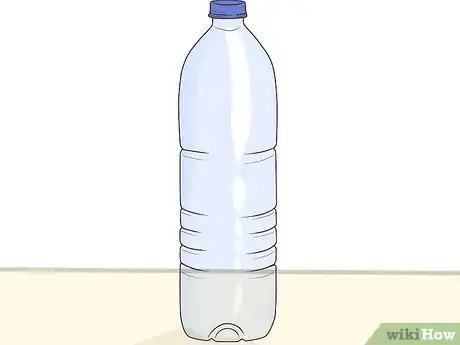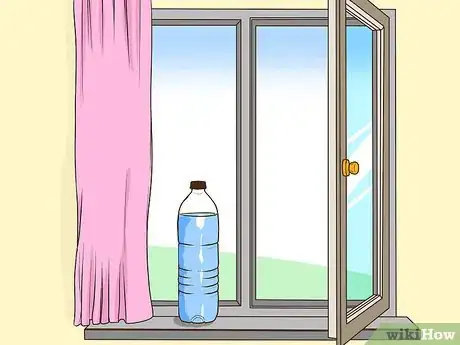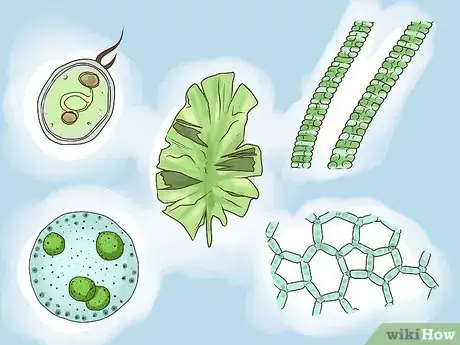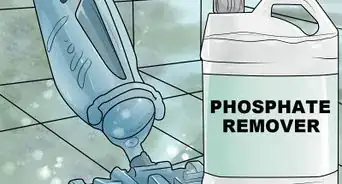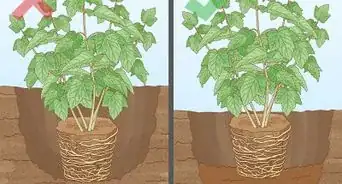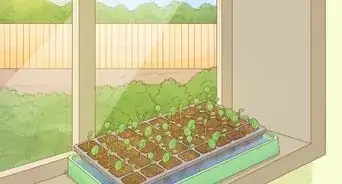This article was co-authored by Katie Gohmann. Katherine Gohmann is a Professional Gardener in Texas. She has been a home gardener and professional gardener since 2008.
There are 9 references cited in this article, which can be found at the bottom of the page.
wikiHow marks an article as reader-approved once it receives enough positive feedback. This article received 13 testimonials and 86% of readers who voted found it helpful, earning it our reader-approved status.
This article has been viewed 510,486 times.
Algae are aquatic plants that grow using the nutrients found in their water and energy from the sun. Many different species of algae are grown, and they have many uses in our lives. Different species of algae can be grown to be everything from a food source to a source of biodiesel for trucks. One of the benefits to growing algae is that the process is easy and straightforward.[1]
Steps
Creating a Growth Medium
-
1Select a container. You should choose a container that is clear and transparent. This will allow sunlight to reach the algae. Glass and clear plastic containers are good choices.
- If you are growing algae for a science fair project, you could use something the size of a plastic water bottle, or something larger like a small aquarium.
-
2Fill the container with water. Your growth medium will be composed primarily of sterilized water. Put the water in your clear container.
- If you are growing microalgae, you should use sterilized salt water.
- If you want to grow spirulina, use clean fresh water. You can use water from any source, such as tap or spring water, as long as it has been filtered with activated carbon or a ceramic filter.[2]
- If you are worried about bacteria, boiling the water before using it will reduce contaminants.[3]
Advertisement -
3Add nutrients to the water. In nature, algae cohabitate with and other aquatic life. These creatures keep the underwater ecosystem balanced and provide plenty of nutrients such as nitrates, phosphates, and silicates to the algae. Your bottle of water will be lacking those nutrients, and micronutrients like trace metals and vitamins unless you add them. You can buy a nutrient solution over the counter, or take some water from a fish tank or pond to supply nutrients.
- Using water from a pond or fish tank could introduce other contaminants into the growth medium.
- You can also mix nutrient solutions. The Walne medium is a nutrient mixture that is suitable for most algae.
- Measuring the effect of different nutrient solutions could be one way to study algae in a science fair project.
-
4Find a place with plenty of sunlight. Before you add the algae, you want to know that you have a proper environment picked out. Look for a windowsill or somewhere outside in the sun that you can safely place your algae container. This will allow the sun to provide the energy needed for the algae to reproduce and thrive in your growing medium. If you have difficulty finding such a location, you can use grow lamps instead.[4]
- Research your algae to determine what type of grow light is best for growing. Normal grow lights designed for plants are not very effective for certain types of algae. You may need to find a light that gives off primarily red and orange light.[5]
- Different types of algae will require different amounts of light, and getting algae too hot (above 35 degrees Celsius, or 95 degrees Fahrenheit) can be lethal to your algae.[6]
Adding an Algae Sample
-
1Select a type of algae. The most up to date estimate suggests that over 70,000 different species of algae exist, and potentially many more species yet to be classified.[7] We use these different types of algae for a host of reasons. Many species of algae are used to produce biofuels to power electrical components. Other types of algae, such as spirulina, are used as a food source. Sometimes, algae is grown in a classroom setting as a science experiment. Your intended use will decide what kind of algae you should grow.[8]
- For example, spirulina would be a good choice if you want to grow algae to supplement your diet.
- Spirogyra plants are sometimes used in science fair projects.
-
2Collect an algae sample. For a basic experiment, you can just use any sample of algae, grow it, and observe it. If you are looking at algal behavior in general, you can just collect an algae sample from any pond, lake, or other natural sources. That said, many different types of algae are found in nature. If you are investigating a particular type, you might want to be more careful about where you get a sample. In this case, you should order your specific algae sample or algae starter from an algaculture supply company, or online.
- For example, many people are interested in growing a type of algae called spirulina. Because spirulina is often eaten, you should get your sample from a reputable company.
- If you are growing algae for a classroom experiment, collecting any sample from a local pond or lake is usually sufficient.
-
3Add the algae to your growth medium. Once you have selected an algae to grow, simply put the sample into your growing medium. Make sure that the appropriate amount of light is still available. Allow the algae time to grow.[9]
- Often, a few weeks may pass before you can see the algae in the container. This is because many species of algae (referred to as microalgae) cannot be seen by the naked eye individually. They must reproduce and generate a high algal population to be visible to the human eye.
- If you are growing a macroalgae species, such as kelp, you will be able to see it.
Monitoring the Algae
-
1Observe any color changes in the growth medium. As your algae grows, it will become more and more compact inside the container. The denser your algae population gets, the more opaque the solution will become. Most algae cultures will be green, but you can get different types of algae that are different colors.[10]
- For example, the strain of algae known as Rhodophyta has a red color.
- Keep a log of all changes that your algae undergo.
-
2Add nutrients when appropriate. For a short term experiment, you will likely only need to add nutrients at the beginning. If you are growing algae on a long term basis, you will need to add nutrients with each new batch of algae. You also might need to add nutrients as the algae population grows. If you are unsure of when to add nutrients or how much to add, consult an algaculture specialist.[11]
- If your algae population becomes too dense, you may have to separate some of it into a new container. Otherwise, the container will be okay as long as you are growing the algae.
-
3Look closer with a microscope. If you wish to learn more about your algae culture, look at it under magnification. Putting a drop of your algae culture on a microscope will likely reveal much more than looking with the naked eye. In addition to your algae, you may even find protozoans or other life forms in your culture.
- This will likely be required if you are growing algae as part of a science experiment for class or work.
Expert Q&A
Did you know you can get expert answers for this article?
Unlock expert answers by supporting wikiHow
-
QuestionWhat do I do with the algae after I grow it?
 Katie GohmannKatherine Gohmann is a Professional Gardener in Texas. She has been a home gardener and professional gardener since 2008.
Katie GohmannKatherine Gohmann is a Professional Gardener in Texas. She has been a home gardener and professional gardener since 2008.
Professional Gardener
-
QuestionCan I use just pond water to grow the algae
 Community AnswerYes. You can grow algae in pond water.
Community AnswerYes. You can grow algae in pond water. -
QuestionHow would I grow the algae in the winter?
 Community AnswerKeep it inside or in a warmer room. You might want to make sure that the water is a bit warmer too, but not so much that it will mess with the algae.
Community AnswerKeep it inside or in a warmer room. You might want to make sure that the water is a bit warmer too, but not so much that it will mess with the algae.
Warnings
- Do not give to children, as they may ingest it.⧼thumbs_response⧽
- Do not eat the algae, unless it is an edible species like spirulina.⧼thumbs_response⧽
References
- ↑ http://allaboutalgae.com/benefits/
- ↑ http://www.algaeindustrymagazine.com/growing-spirulina-at-home/
- ↑ http://traveltips.usatoday.com/long-boil-water-purification-62933.html
- ↑ http://www.fao.org/docrep/003/w3732e/w3732e06.htm
- ↑ http://www.algaeindustrymagazine.com/growing-spirulina-at-home/
- ↑ http://www.education.com/science-fair/article/growing-algae/
- ↑ http://www.seaweed.ie/guiry/pdfs/How_Many_Published.pdf
- ↑ http://allaboutalgae.com/algae-cultivation/
- ↑ https://www.teachengineering.org/activities/view/usf_microbes_lesson01_activity2
About This Article
To grow your own algae, first you’ll need a clear plastic or glass container. You can use a plastic water bottle to grow a small amount of algae or a glass aquarium to grow more. Fill the container with purified water, then add a nutrient solution, which you can buy at a pet store or online. The nutrient solution will provide the algae with the nutrients it needs to grow. Once that’s mixed in, add a sample of the type of algae you want to grow to the container. Place the container in a bright, sunny spot, and aim to keep the temperature around 84-93°F (29-34°C). As your algae starts to grow, the water will become greener and more opaque. After 8-10 days, you can transfer some of the algae to a bigger container if you’d like and use it to start growing new algae in other containers. Each time you start growing a new batch of algae, add more nutrient solution. For tips from our Horticulture reviewer on interesting things to observe as the algae grows, read on!
